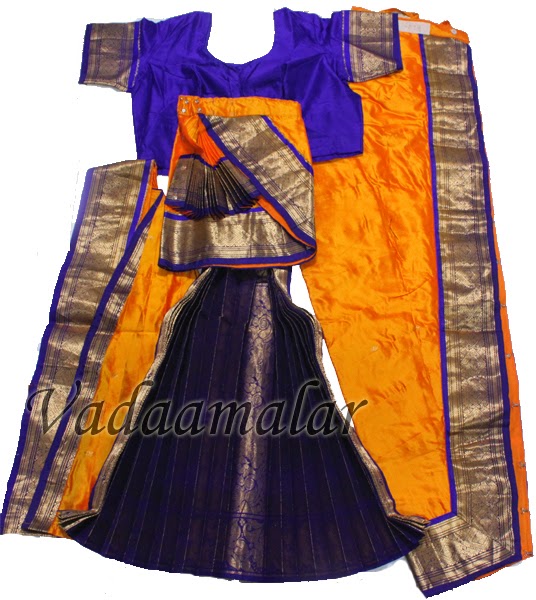Classical Dances of India
Classical dance forms are performed inside the holy places based on the rituals. These rituals are also called Agama Nartanam. The dance forms in classical are characterized based on the grace and precision of the movements.Also, it includes steps, poses, and gestures.
The classical dance in India is based on Natya Shastra and are of enlightenment.
Bharatnatyam
Tamil Nadu, South India
Bharatnatyam is one of the most popular forms of dances in India. It is said to be originated in Thanjavur district of Tamil Nadu. Performed on the celestial tunes of the Carnatic music, Bharatnatyam comes from Thanjavur district of Tamil Nadu in South.
The origins of Bharatnatyam can be traced back to 1000 BC, and it originates from the ancient temples of Tamil Nadu performed by the women of the ancient period. The dance form is known for its beautiful body movements and gestures which are called Mudras in the traditional language. It focuses on the hand gestures, leg movement and the facial expressions of the dancer. This dance form was very prevalent before the British era but was highly depressed during the colonial period. However, India kept the dance form alive in the houses, and today it is recognised as one of the most respectable art forms in India especially in the Southern region of the country where it is pride for the women of the house to learn the classical dance form of Bharatnatyam. Further, there are three concepts that are given preference in Bharatnatyam. They are raga, thaala, and bhava.
Ghommar
Rajasthan,North West India
Ghoomer is a popular form of dance in Rajasthan. It is derived from the word ‘ghoomna’ which in Hindi means to roam. Hence, in this dance, the performers carry earthen pots and use their slick movements of hands and feet. Wearing the heavy jewellery and the beautiful costumes you will find the people of Rajasthan dancing on the beats of music to give away their traditional dance form. Ghoomar includes the intriguing circular movements complemented by the hand gestures.
Kathak
Utterpradesh, North India
Coming from the northern part of the country from the state of Uttar Pradesh, Kathak comes from the word 'Katha' which means "story" in Hindi. It isn't a very smart guess for one to make that Kathak is performed in the form of storytelling through the body movements used by the dancer. Kathak is often referred to as the dance of love, and it can be performed by both by the male and female dancer together. This dance form focuses highly on the ankle movements complemented by the ankle that has to match the beats of the music. Ankle bells or gunghroos as they are called in the traditional language is an important part of the discipline of this dance form. Various distinctions can be witnessed in this dance forms as it is performed in various places in the country which includes Jaipur, Benaras, and Lucknow.
Kathakali
Kerala, South India
Kathakali is another traditional dance form of India which relates to the storytelling. Kathakali translates to the 'storyteller' in the country's language. Coming from the Southern region of the country from Kerala, Kathakali is one of the most renowned and religious dances forms of India. It originates from the tales of Ramayana and Shiva stories. Kathakali includes the intriguing face movements and the heavy costumes which include the traditional face masks and body paints (generally green). The music which includes only the vocals is called soppanam. The storytelling of the epic Hindu mythology tales depicting both evil and good is shown through the conversation between the dancers only through their body gestures and facial expressions. Simply fascinating to watch!
Manipuri
Manipur, North Eastern India
As you stroll towards the North-east India which is brimming with the rich tradition and their unique culture, Manipuri comes as an important symbol to represent the state of Manipur from the region. This dance form is performed to narrate the romantic relationship between the Hindu gods Radha and Krishna, which is famously known as RaasLeela. This art form is performed in a team with the traditional Manipuri costumes and makeup to narrate the tale of the two gods. The dance is performed on the narrative chanting and the music created by the Indian classical instruments.
Kuchipudi
Andhra Pradesh, South India
Belonging to the Andhra Pradesh, Kuchipudi is probably the toughest form of classical dance in India. Kuchipudi is not just considered as the dance but a whole religious procedure dedicated to God which includes certain rituals such as sprinkling the holy water, burning the incense sticks and praying to God. Kuchipudi includes both singing and dancing by the performer which is why it requires both the skill and much more dedication than any other art forms in India. In the earlier period, Kuchipudi was only performed by the male dancers in the temples, specifically the Brahmins( Upper caste of the society) but with the passage of time, it became famous amongst the women and nowadays it is mostly performed by the female dancers.


























